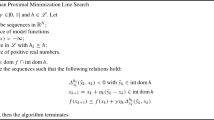Abstract
A new variational problem for accurate approximation of the distance from the boundary of a domain is proposed and studied. It is shown that the problem can be efficiently solved by the alternating direction method of multipliers. Links between this problem and \(p\)-Laplacian diffusion are established and studied. Advantages of the proposed distance function estimation method are demonstrated by numerical experiments.





Similar content being viewed by others
REFERENCES
F. Gibou, R. Fedkiw, and S. Osher, “A review of level-set methods and some recent applications,” J. Comput. Phys. 353, 82–109 (2017).
P. G. Tucker, “Hybrid Hamilton–Jacobi–Poisson wall distance function model,” Comput. Fluids 44 (1), 130–142 (2011).
B. Roget and J. Sitaraman, “Wall distance search algorithm using voxelized marching spheres,” J. Comput. Phys. 241, 76–94 (2013).
A. Biswas, V. Shapiro, and I. Tsukanov, “Heterogeneous material modeling with distance fields,” Comput. Aided Geom. Des. 21, 215–242 (2004).
H. Xia and P. G. Tucker, “Fast equal and biased distance fields for medial axis transform with meshing in mind,” Appl. Math. Model. 35, 5804–5819 (2011).
I. Babuška, U. Banerjee, and J. E. Osborn, “Survey of meshless and generalized finite element methods: A unified approach,” Acta Numer. 12, 1–125 (2003).
M. Freytag, V. Shapiro, and I. Tsukanov, “Finite element analysis in situ,” Finite Elem. Anal. Des. 47 (9), 957–972 (2011).
C. Cadena, L. Carlone, H. Carrillo, Y. Latif, D. Scaramuzza, J. Neira, I. Reid, and J. J. Leonard, “Past, present, and future of simultaneous localization and mapping: Toward the robust-perception age,” IEEE Trans. Rob. 32, 1309–1332 (2016).
F. Calakli and G. Taubin, “SSD: Smooth signed distance surface reconstruction,” Comput. Graphics Forum 30 (7), 1993–2002 (2011).
M. Zollhöfer, A. Dai, M. Innmann, C. Wu, M. Stamminger, C. Theobalt, and M. Nießner, “Shading-based refinement on volumetric signed distance functions,” ACM Trans. Graphics 34 (4), 96:1–96:14 (2015).
B. Zhu, M. Skouras, D. Chen, and W. Matusik, “Two-scale topology optimization with microstructures,” ACM Trans. Graphics 36 (5), 36:1–36:14 (2017).
A. Belyaev, P.-A. Fayolle, and A. Pasko, “Signed Lp-distance fields,” Comput.-Aided Des. 45, 523–528 (2013).
K. Crane, C. Weischedel, and M. Wardetzky, “Geodesics in heat: A new approach to computing distance based on heat flow,” ACM Trans. Graphics 32, 152:1–152:11 (2013).
A. Belyaev and P.-A. Fayolle, “On variational and PDE-based distance function approximations,” Comput. Graphics Forum 34 (8), 104–118 (2015).
B. Lee, J. Darbon, S. Osher, and M. Kang, “Revisiting the redistancing problem using the Hopf–Lax formula,” J. Comput. Phys. 330, 268–281 (2017).
M. Royston, A. Pradhana, B. Lee, Y. T. Chow, W. Yin, J. Teran, and S. Osher, “Parallel redistancing using the Hopf–Lax formula,” J. Comput. Phys. 365, 7–17 (2018).
R. Glowinski, “On alternating direction methods of multipliers: A historical perspective,” in Modeling, Simulation, and Optimization for Science and Technology, Ed. by W. Fitzgibbon, Y. A. Kuznetsov, P. Neittaanmäki, and O. Pironneau (Springer, 2014), pp. 59–82.
A. Belyaev and P.-A. Fayolle, “A variational method for accurate distance function estimation,” in Lecture Notes in Computational Science and Engineering, Vol. 131: Numerical Geometry, Grid Generation, and Scientific Computing, NUMGRID 2018/Voronoi 150 (Springer International, Berlin, 2019).
T. Bhattacharya, E. DiBenedetto, and J. Manfredi, “Limits as p → ∞ of Δpup = f and related extremal problems,” Rend. Sem. Mat. Univ. Pol. Torino, Fascicolo Speciale Nonlinear PDEs (1989), pp. 15–68.
B. Kawohl, “On a family of torsional creep problems,” J. Reine Angew. Math. 410 (1), 1–22 (1990).
N. A. Wukie and P. D. Orkwis, “A p-Poisson wall distance approach for turbulence modeling,” in 23rd AIAA Computational Fluid Dynamics Conference (2017).
G. Pólya and G. Szego, Isoperimetric Inequalities in Mathematical Physics (Princeton University Press, Princeton, 1951).
P.-A. Fayolle and A. Belyaev, “p-Laplace diffusion for distance function estimation, optimal transport approximation, and image enhancement,” Comput. Aided Geom. Des. 67, 1–20 (2018).
P. Butzer and F. Jongmans, “P.L. Chebyshev (1821–1894): A guide to his life and work,” J. Approximation Theory 96, 111–138 (1999).
ACKNOWLEDGMENTS
The Gargoyle mesh model is courtesy of AIM@SHAPE and the Lucy mesh model is courtesy of the Stanford Graphics Laboratory.
Author information
Authors and Affiliations
Corresponding authors
Rights and permissions
About this article
Cite this article
Fayolle, PA., Belyaev, A.G. On Variational and PDE-Based Methods for Accurate Distance Function Estimation. Comput. Math. and Math. Phys. 59, 2009–2016 (2019). https://doi.org/10.1134/S0965542519120066
Received:
Revised:
Accepted:
Published:
Issue Date:
DOI: https://doi.org/10.1134/S0965542519120066




